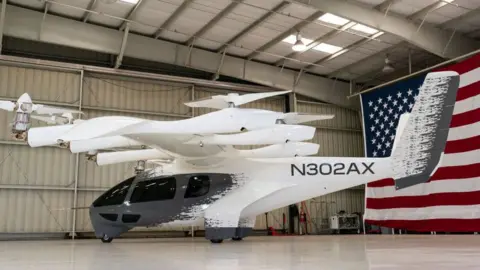The plans for the 2028 Olympics in Los Angeles have taken a bold leap into the future, showcasing ambitions of transforming urban transportation. As more spectators anticipate the forthcoming Summer Games, the Los Angeles 2028 Organizing Committee, commonly referred to as LA28, has recently announced an exciting partnership with Archer Aviation aimed at introducing an air taxi service for the event. This initiative seeks to alleviate one of the major concerns associated with mass gatherings in a bustling city: traffic congestion.
The 2028 Olympic Games, marking the third occurrence of the Olympics hosted by Los Angeles—previously held in 1932 and 1984—aim to give attendees an integrated travel experience that allows them to bypass the notoriously gridlocked streets of the city. The air taxi service will operate with a fleet of innovative electric vertical take-off and landing (eVTOL) aircraft. These vehicles, such as the Midnight aircraft developed by Archer Aviation, promise to ferry fans to and from venues, showcasing a novel approach to enhancing mobility during these high-profile international sports events.
However, the implementation of an air taxi service is not without its challenges. Archer Aviation is still awaiting certification from the U.S. Federal Aviation Administration (FAA) before its aircraft can hit the skies for commercial use. The company’s founder and CEO, Adam Goldstein, has expressed optimism that the necessary Type Certification could be granted as early as this year, pending approval that verifies the aircraft’s adherence to safety and design standards.
If certification comes through in time for the Olympic Games, the service could offer short flights of 10 to 20 minutes between selected destinations, which would include some of the primary venues such as the Los Angeles Memorial Coliseum and the SoFi Stadium. Though the pricing for these air taxi trips remains undetermined, it has been indicated that efforts will be made to keep costs comparable to those of premium ride-hailing services like Uber, enabling more attendees to take advantage of this futuristic mode of transport.
The vehicles, capable of carrying up to four passengers, will operate similarly to helicopters but are designed to produce less noise and fewer emissions, paving the way for more environmentally friendly urban air travel. The aim is to create a user experience reminiscent of widely-used ride-hailing apps, where users can summon an air taxi at their convenience with a simple request through a mobile application.
The innovative air taxi venture aligns with the city’s vision to reduce car usage during the 2028 Games—a significant move, especially considering prior challenges faced in expanding the area’s existing public transportation systems. The larger ambition is to leave a lasting legacy by reshaping transportation options in Los Angeles and beyond, transforming how people navigate urban environments.
Despite the enthusiasm surrounding flying taxis, the industry has faced numerous hurdles, including regulatory concerns and technological limitations such as battery efficiency and safety standards. Moreover, Archer Aviation is not the only company entering this burgeoning market; it operates in a field alongside several other eVTOL manufacturers vying to revolutionize short-haul air travel.
As part of this transformation plan, various government bodies are optimistic about the future of urban air mobility, with initiatives like the UK’s Future of Flight action plan, predicting flying taxis could make their debut by 2026. This reflects a broader vision for the future of urban air transport—where flying taxis could alleviate not only traffic woes but also aid in reducing pollution as part of a wider global shift towards sustainable travel options.
In sum, LA28’s collaboration with Archer Aviation seeks to not only enhance the spectator experience at the 2028 Olympic Games but also play a pivotal role in redefining public transport within urban settings. As the countdown to the Games continues, all eyes will be on how these ambitious plans progress and materialize.



